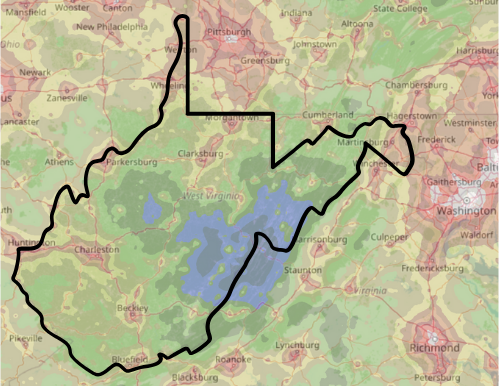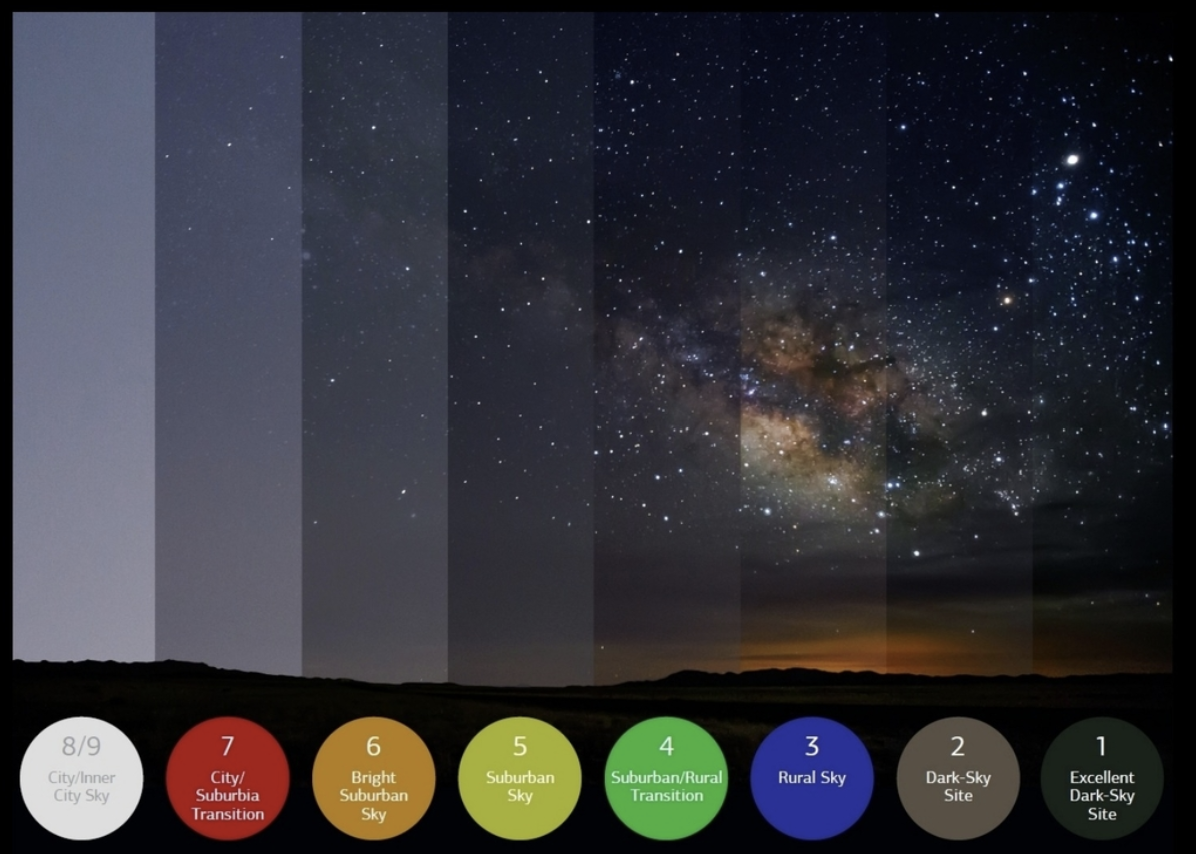
Light Pollution in West Virginia
This Science & Technology Note provides an overview of the effects of light pollution on people, animals, and plants, gives information on recent increases in light pollution, and highlights legislation that states have implemented in an effort to preserve dark skies.
Artificial Light at Night and Light Pollution
Artificial light at night (ALAN) produces three main types of light pollution: skyglow, light trespass, and glare. Skyglow brightens the night sky over inhabited areas, affecting more than 99% of Americans. Glare (excessive brightness leading to visual disturbances) and light trespass (lights shining where they are unwanted) have been shown to decrease safety and waste energy. Nearly 30% of outdoor lighting is directed at the sky, costing over $1.4 billion in energy in the U.S. alone. For example, electronic billboards are 10 times brighter than traditional billboards and emit light in all directions, including into the sky. Outdoor lights are often promoted as a safety feature, but research is mixed on whether outdoor lights promote or deter crime. However, it is important to note that outdoor lights often make people feel safer, even if they don’t actually impact safety.
Light color, which depends on the light’s wavelength, also affects how much light pollution is produced. Blue light produces more glare and skyglow than red light. This phenomenon is often observed with car headlights. Newer LED lights generally emit 20-50% of their light in blue wavelengths, while older generations of lights ranged from 5-20% blue light. As LEDs now account for more than 50% of light sales, it could be advantageous to incorporate light pollution reduction strategies into lighting plans. The Illuminating Engineering Society and DarkSky International have developed 5 key principles for responsible outdoor lighting: light should be useful, targeted, low-level, controlled, and warm-colored.
West Virginia’s Skies
West Virginia is one of the darkest places in the eastern United States, making it an ideal place for astrotourism and scientific research alike. The Green Bank Observatory, home to seven radio telescopes, contributes nearly $30 million annually to West Virginia’s economy. Watoga State Park, Calvin Price State Forest, and Droop Mountain Battlefield State Park make up West Virginia’s first and only certified Dark Sky Park, areas that are recognized for their low levels of light pollution and efforts to educate the public about light pollution. However, as light pollution continues to increase, these sites may lose their darkness. The National Park Service has documented skyglow in dark sky sites up to 200 miles away from the nearest city.
Research Highlights
Skyglow, light trespass, and glare are forms of light pollution. Using lights that are targeted, warm-colored, controllable, and as dim as possible can reduce light pollution.
West Virginia is one of the darkest places in the Eastern US and has had a designated Dark Sky Park since 2021.
Artificial light at night can contribute to health and environmental issues.
States have taken various approaches to protecting night skies, including implementing lighting standards for state-owned buildings, requiring lights to be shielded or extinguished, and implementing special restrictions for environmental or industrial impacts.
West Virginia contains the region’s darkest skies (blue). Areas of high light pollution, such as the Washington, DC and Pittsburgh metro areas, are shown in red and white. Adapted from Light Pollution Map (2025).
How does ALAN impact people, animals, and plants?
Studies on human exposure to ALAN have linked light exposure to increased risks of sleep disorders, mood disorders, dementia, obesity, cardiovascular disease, and cancers, including breast cancer, prostate cancer, and skin cancer. Susceptibility to ALAN can vary greatly between individuals.
ALAN has been known to negatively impact animals since the early 1900s. Now, scientists have determined that ALAN has negative effects on many species, including species in West Virginia. Tests near the Ohio River demonstrated a 16% decrease in biodiversity and a 62% reduction in nocturnal pollinators, including moths and other insects, in areas with high levels of light. Flying animals, such as bats, fireflies, and birds, are known to be particularly sensitive to ALAN.
West Virginia is home to 3 endangered bat species, is one of four states with synchronous firefly populations, and is part of a key bird migration zone. ALAN has been shown to negatively impact these animal populations. In bats, ALAN causes delays in leaving their nest to hunt, increases airborne collisions, and decreases sexual activity, contributing to population decline. Brighter nights make it more difficult for fireflies to recognize each other and disrupt their mating process. Finally, as migratory birds rely on the length of daylight and position of the sunset and stars, ALAN can delay migration and cause birds to get lost.
ALAN can also impact plants. ALAN may delay fall tree coloration and leaf dropping, although these are also heavily temperature dependent, potentially impacting fall tourism activity in the state. Loss of pollinators may endanger reproduction of many plant species. According to DarkSky International, a light pollution think tank, ALAN is considered to be “one of the most pressing and imminent threats to global biodiversity.”
Depending on location, most of West Virginia has brightness measurements between 3-8. The brightest parts of Charleston, Huntington, Parkersburg, and Wheeling all measure between 7-8, while Pocahontas County contains areas with a score of 3. Source: The Effects of Light Pollution in Deep-Sky Imaging.
Dark Sky Legislation
19 states, Washington, D.C., and Puerto Rico have enacted legislation to reduce light pollution. Arizona is a leader in dark sky preservation. Since 1986, Arizona has required all outdoor light fixtures to be downward directed, with specific exemptions. Today, 11 states have implemented regulations on light fixtures on state property or that were installed using state funds. Texas has additional restrictions on lights that may interfere with military training. Florida and Minnesota, while leaving regulation of ALAN to the local level, have each developed model lighting ordinances that municipalities can adopt. Several dark sky bills have also been introduced at the federal level. West Virginia code addresses lights that may impact motorists, but provides no guidance for preservation of the night sky. In 1999, West Virginia introduced HB 2995, designed to apply dark sky principles to new light installations, but the bill never advanced. Opponents to dark sky legislation often cite short deadlines to comply with laws and cost to update light fixtures, as well as interference with their choice to have lights outdoors.
Should policymakers wish to address this issue, West Virginia could revisit the 1999 lighting regulation bill, ensure it is up-to-date with current lighting design standards while addressing concerns for safety and areas that require continuous lighting, and implement it. The bill currently addresses which lights it applies to, types and operation of lighting, and shielding requirements, while providing exemptions for airport, security, and temporary lighting. In an effort to alleviate concerns held by opponents, Colorado’s law only applies to newly installed fixtures, and Arizona allows non-compliant lights if they will not be illuminated between midnight and sunrise.
This Science and Technology Note was prepared by Madison Flory, PhD, West Virginia Science & Technology Policy Fellow on behalf of the West Virginia Science and Technology Policy (WV STeP) Initiative. The WV STeP Initiative provides nonpartisan research and information to members of the West Virginia Legislature. This Note is intended for informational purposes only and does not indicate support or opposition to a particular bill or policy approach. Please contact info@wvstep.org for more information.

